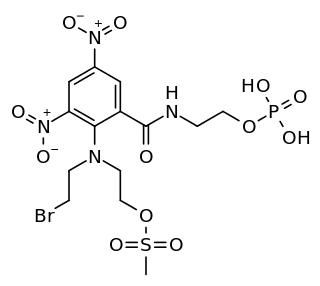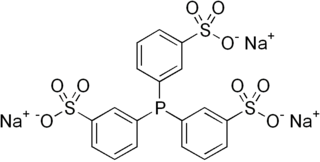 W
WA sulfonate is a salt or ester of a sulfonic acid. It contains the functional group R-SO3−, where R is an organic group. Sulfonates are the conjugate base of sulfonic acids. Sulfonates are generally stable in water, non-oxidizing, and colorless. Many useful compounds and even some biochemicals feature sulfonates.
 W
WN-Acetyltaurine (NAcT) is an endogenous metabolite. Biochemically, N-acetyltaurine is formed as a result of an acetylation of taurine. The main substrate for this reaction is acetate. An increase of endogenous N-acetyltaurine concentrations was observed after the consumption of alcohol and after extended physical activity (ketoacidosis).
 W
W2-Acrylamido-2-methylpropane sulfonic acid (AMPS) was a Trademark name by The Lubrizol Corporation. It is a reactive, hydrophilic, sulfonic acid acrylic monomer used to alter the chemical properties of wide variety of anionic polymers. In the 1970s, the earliest patents using this monomer were filed for acrylic fiber manufacturing. Today, there are over several thousands patents and publications involving use of AMPS in many areas including water treatment, oil field, construction chemicals, hydrogels for medical applications, personal care products, emulsion coatings, adhesives, and rheology modifiers.
 W
WAlkylbenzene sulfonates are a class of anionic surfactants, consisting of a hydrophilic sulfonate head-group and a hydrophobic alkylbenzene tail-group. Along with sodium laureth sulfate they are one of the oldest and most widely used synthetic detergents and may be found in numerous personal-care products and household-care products . They were first introduced in the 1930s in the form of branched alkylbenzene sulfonates (BAS). However following environmental concerns these were replaced with linear alkylbenzene sulfonates (LAS) during the 1960s. Since then production has increased significantly from about 1 million tons in 1980, to around 3.5 million tons in 2016, making them most produced anionic surfactant after soaps.
 W
WBisdisulizole disodium is a water-soluble organic compound which is added to sunscreens to absorb UVA rays. It is marketed by Symrise.
 W
WCalcium dobesilate is a vasoprotective. It is the calcium salt of dobesilic acid. It is a synthetic molecule with the ability to reduce capillary permeability in the body. In Switzerland the drug is sold by the pharmaceutical company OM Pharma under the trade name of Doxium® in capsules containing 500 mg of active ingredient.
 W
WCarbyl sulfate is an organosulfur compound. The white solid is the product of the reaction of sulfur trioxide and ethylene. It is used in preparation of some dyes and other organosulfur compounds. Carbyl sulfate is a colorless, crystalline, hygroscopic substance although commercial product can appear as a liquid. Because of its unpleasant properties carbyl sulfate is difficult to handle and is usually not isolated but further processed to give secondary products.
 W
WCefsulodin is a third-generation cephalosporin antibiotic that is active against Pseudomonas aeruginosa and was discovered by Takeda Pharmaceutical Company in 1977.
 W
WCerium(III) methanesulfonate is a white salt, usually found as the dihydrate with the formula Ce(CH3SO3)3·2H2O that precipitates from the neutralisation of cerium(III) carbonate with methanesulfonic acid, as first reported by L.B. Zinner in 1979. The crystals have a monoclinic polymeric structure were each methanesulfonate ion forms bonds with two cerium atoms, which present a coordination number of 8. The anhydrous salt is formed by water loss at 120 °C. Similar methanesulfonates can be prepared with other lanthanides. Cerium(III) methanesulfonate in solution is used as a precursor of electrogenerated cerium(IV), which is a strong oxidant and whose salts can be used in organic synthesis. The same principle of Ce(IV) electrogeneration is the fundamental reaction in the positive half-cell of the zinc–cerium battery.
 W
WCoenzyme M is a coenzyme required for methyl-transfer reactions in the metabolism of methanogens. The coenzyme is an anion with the formula HSCH2CH2SO−3. It is named 2-mercaptoethanesulfonate and abbreviated HS–CoM. The cation is unimportant, but the sodium salt is most available. Mercaptoethanesulfonate contains both a thiol, which is the main site of reactivity, and a sulfonate group, which confers solubility in aqueous media.
 W
WDirect Blue 1 is an organic compound that is one of many azo dyes. It is used as a substantive dye for textiles with high contents of cellulose, i.e. cotton. It is prepared by the azo coupling of the aminonaphthalene and diazotized derivative of o-dianisidine.
 W
WFluorosulfonate, in organic chemistry, is a functional group that has the chemical formula F-SO2-O-R, and typically is a very good leaving group. In inorganic chemistry, fluorosulfonate is another term for fluorosulfate, the anion F-SO2-O−, the conjugate base of fluorosulfonic acid. They form a series of salts with metal and organic cations called fluorosulfates.
 W
WIndigo carmine, or 5,5′-indigodisulfonic acid sodium salt, is an organic salt derived from indigo by sulfonation, which renders the compound soluble in water. It is approved for use as a food colorant in the U.S and E.U. It has the E number E132. It is also a pH indicator.
 W
WIndocyanine green (ICG) is a cyanine dye used in medical diagnostics. It is used for determining cardiac output, hepatic function, liver and gastric blood flow, and for ophthalmic angiography. It has a peak spectral absorption at about 800 nm. These infrared frequencies penetrate retinal layers, allowing ICG angiography to image deeper patterns of circulation than fluorescein angiography. ICG binds tightly to plasma proteins and becomes confined to the vascular system. ICG has a half-life of 150 to 180 seconds and is removed from circulation exclusively by the liver to bile juice.
 W
WLucifer yellow is a fluorescent dye used in cell biology. The key property of Lucifer yellow is that it can be readily visualized in both living and fixed cells using a fluorescence microscope. Lucifer yellow was invented by Walter W. Stewart at the National Institutes of Health and patented in 1978.
 W
WMerocyanines are a class of polymethine dyes which are clearly defined by set structural properties. Merycyanines belong to the group of dyes referred to as functional dyes, where their applications are not only determined by their colour, but also their valuable chemical properties.
 W
WMesna, sold under the brand name Mesnex among others, is a medication used in those taking cyclophosphamide or ifosfamide to decrease the risk of bleeding from the bladder. It is used either by mouth or injection into a vein.
 W
WIn chemistry, a mesylate is any salt or ester of methanesulfonic acid (CH3SO3H). In salts, the mesylate is present as the CH3SO3− anion. When modifying the International Nonproprietary Name of a pharmaceutical substance containing the group or anion, the correct spelling is mesilate (as in imatinib mesilate, the mesylate salt of imatinib).
 W
WMetamizole, or dipyrone, is a painkiller, spasm reliever, and fever reliever that also has anti-inflammatory effects. It is most commonly given by mouth or by injection.
 W
WMetanil Yellow is a dye of the azo class. In analytical chemistry, it is used as a pH indicator and it has a color change from red to yellow between pH 1.2 and 2.3.
 W
WMethiodal is a molecule used as a contrast medium.
 W
WPR-104 is a drug from the class of hypoxia-activated prodrugs (HAPs), which is being researched as a potential anti-cancer therapeutic agent. It is a phosphate ester “pre-prodrug” that is rapidly converted to the HAP PR-104A in the body. PR-104A is in turn metabolised to reactive nitrogen mustard DNA crosslinking agents in hypoxic tissues such as found in solid tumours. Following initial clinical studies, it was discovered that PR-104A is also activated by the enzyme AKR1C3, independently of hypoxia. Hypoxia in the bone marrow of patients with leukaemia, and high activity of AKR1C3 in some leukaemia subtypes has led to interest in clinical trials of PR-104 in relapsed refractory acute leukaemias.
 W
WPyranine is a hydrophilic, pH-sensitive fluorescent dye from the group of chemicals known as arylsulfonates. Pyranine is soluble in water and has applications as a coloring agent, biological stain, optical detecting reagent, and a pH indicator. One example would be the measurement of intracellular pH. Pyranine is also found in yellow highlighters, giving them their characteristic fluorescence and bright yellow-green colour. It is also found in some types of soap.
 W
WScarlet GN, or C.I. Food Red 1, Ponceau SX, FD&C Red No. 4, or C.I. 14700 is a red azo dye once used as a food dye. As a food additive, it has the E number E125. It usually used as a disodium salt.
 W
WSodium 2-anthraquinonesulfonate (AMS) is a water-soluble anthraquinone derivative. In the laboratory it could be prepared by sulfonation of anthraquinone.
 W
WSodium 2-hydroxyethyl sulfonate is the sodium salt of 2-hydroxyethane sulfonic acid, it is used as a hydrophilic head group in washing-active surfactants, known as isethionates (acyloxyethanesulfonates) due to its strong polarity and resistance to multivalent ions. It is being studied as a high production volume chemical in the "High Production Volume (HPV) Chemical Challenge Program" of the US Environmental Protection Ministry EPA.
 W
WSodium apolate (INN) or lyapolate sodium (USAN) is a vasoprotective.
 W
WStibophen is an anthelmintic classified as antimony compound and used as treatment of schistosomiasis by intramuscular injection.
 W
WTiron is a chemical compound used for its ability to form strong complexes with titanium and iron, as well as mixed compounds such as calcium titanium tiron.
 W
WTitan yellow is a compound with formula C28H19N5Na2O6S4. It is a triazene dye used as a stain and fluorescent indicator in microscopy. It is also used as a reagent for the detection of magnesium. As an acid-base indicator, it changes color from yellow to red between pH 12 and pH 13.
 W
W3,3′,3″-Phosphanetriyltris(benzenesulfonic acid) trisodium salt (abbreviated TPPTS when isolated and tppts as a ligand), is an organic compound that is also known as sodium triphenylphosphine trisulfonate. The compound has the formula P(C6H4SO3Na)3. This white microcrystalline solid is an unusual example of a water-soluble phosphine. Its complex with rhodium is used in the industrial production of butyraldehyde.